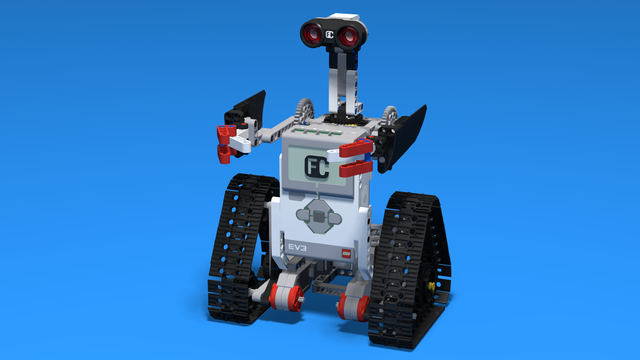There are two types of inertia to familiarize yourself with. One you know intuitively, while the other is more obscure. Both must be considered when building your own robots, especially in future competitions.

To access the full video please subscribe to FLLCasts.com
- #901
- 17 Dec 2018
What is inertia?
In Physics, inertia means that an object in motion will remain in motion, and an object at rest will remain at rest unless some outside force stops or starts the object.

Inertia In Motion
One type of inertia is inertia in motion. You can easily understand this if you imagine running very fast. Are you able to stop immediately? No. Another typical example is when you are cycling and want to stop. You apply the brake, the wheel stops spinning, but the bike continues to move, leaving black rubber strips on the asphalt as evidence of the inertia.
Take a look at an interesting video of a master pilot of a helicopter: https://youtu.be/JKnzzYk4vLo
Is inertia an issue when building robots?
Yes, in many cases, the robots we design can have the wrong center of mass, and the center of mass is crucial for us to have well-balanced robots.
For the robots we design in class, the center of mass is the heaviest part of the robot, typically the brick. In today's robot, the brick is positioned far ahead of the motors, third wheel, and tires. This causes the front of the robot to tilt and even tumble to the ground when stopped suddenly.
There are, of course, solutions to this problem: modify the construction so that the center of mass is correctly positioned within the triangle formed by the robot's three contact points.
In the field of robotics, there are two main disciplines: construction and programming. In some cases, issues related to inertia can be resolved through changes in the robot's programming.
Inertia At Rest
Another type of inertia is where an object at rest tends to remain stationary. For example, consider a plate on a silk cloth.
Do not try this at home: https://youtu.be/nSj_MVUsBzg
A teacher may demonstrate this experiment using a piece of paper and a smooth, heavy object, such as a LEGO motor or an Intelligent Brick. However, we are not responsible if something falls and breaks!
Courses and lessons with this Tutorial
This Tutorial is used in the following courses and lessons

Level B1. "Spy gadgets". Robotics with LEGO
The third level of the Robotics with LEGO curriculum for students in second, third or fourth grades.
In these lessons, we stress on more complex and challenging robots. The concept of Condition is introduced. Students learn about physics concepts of inertia and center of mass. Robots with two sensors are built and students program both of them. Programming becomes more complex as robots now can make complex decisions. "Spy"-robots sneakily follow their targets, trying to be undetected.
- 30
- 7:30
- 108

Lesson 4 - Inertia
Introduction
One spy, of course, has his own super-car. In order to use the car to the best of its abilities, one must be aware of some physics concepts. In this lesson, we will build a robot that practically demonstrates what is inertia.

- 2
- 3
- 3
- 3d_rotation 1
![Image for [In Development] The fun level - Game-oriented introduction to LEGO robotics](https://d2nmr6p48f8xwg.cloudfront.net/content_pictures/pictures/000/002/636/a4f229bae5979562f6bfe32adc6281e577e312674a0cc5c98f8fdfe15e7c7da9b89f826a037575a5LEGO-Mindstorms-Ev3-Yolanda-Sailship-Robot-Fllcasts.png)
[In Development] The fun level - Game-oriented introduction to LEGO robotics
A level, designed for introduction in LEGO-robotics, focused mostly on games. We use goal-oriented challenges to make the students want to accomplish a certain task, learning a lot in the process. Some of the games we have included here are football, bowling, paper-plane competition and many more. It is suitable for studens 8 to 12 years old, but even older students will have a lot of fun with the activities.
This is a brand new course that we are experimenting with in a groups in June 2019. Keep in mind that it is possible to use it for summer camps and groups, but there are a few lessons that will be improved on the fly.
- 38
- 42:14
- 40

Robotics with LEGO - Level 1.5 - Spy games
The second level of the Robotics with LEGO curriculum for students from fifth to twelfth grades.
Students build multiple robots with thread chains and become familiar with the physical concepts of momentum and center of gravity. The concept of gears, their use and basic constructions involving gears are studied.
The new concept of "condition" is introduced in programming. Robots are becoming smarter as they can make complex decisions on their own. "Spy robots" follow their targets and avoid being noticed. This level introduces the light sensor which the robots use to recognize the colors of the objects they are looking for. Robots can stop on a black line and follow a route marked with a colored line on the floor.
The spy's most complex mission in the end of the level is to turn into a sumo wrestler and defeat any other robot in the ring.
- 56
- 12:47
- 136

Level B1 - Carnival - Robotics with LEGO SPIKE Prime
This is the third level of the LEGO Robotics Curriculum for students in second, third, or fourth grades.
Carnival and Amusement Park Level. Each lesson has a theme related to carnivals and amusement parks. Students learn about physics concepts of inertia, center of mass, and centrifugal force. New ways of programming the force and distance sensors are introduced. We work with new concepts: forever loop, if/then, and if/else.
- 23
- 1:03
- 62

Lesson 4 - Bumper car
Introduction
Have you ever been in a bumper car? Have you driven such a car?

In this lesson, we will build a bumper car and program it to sense when it has been bumped! The first patent for a bumper car ride was published in 1921, and since then, bumper cars have been a staple attraction all over the world. Even some cruise ships have bumper car rides!
- 3
- 5
- 8
- 3d_rotation 1

